CO2 is considered an important component of every aquarium. This component of water provides an important part of the life of all living creatures that live in an artificial ecosystem. Each aquarist should be aware of the functions, feeding features and options for controlling the amount of carbon dioxide in the aquarium.
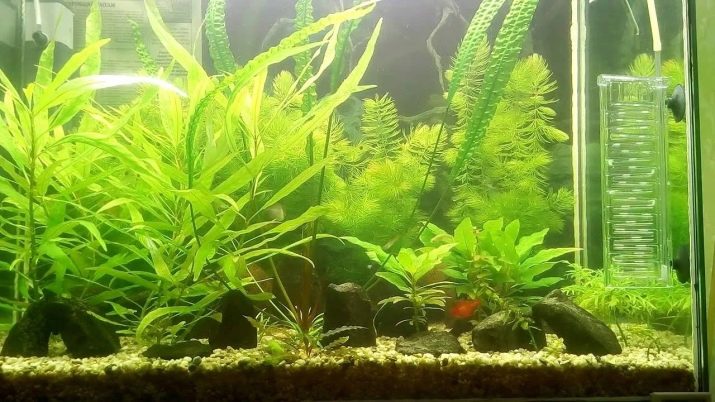
Features and purpose
CO2 is a gas that provides respiration to aquarium plants. Representatives of the flora are half composed of this component. In a natural body of water, it is enough for the normal functioning of aquatic vegetation, but in domestic reservoirs it is very small. Despite the fact that the fish produce CO2 in the aquarium, it is still not enough for the full breath of algae and underwater bushes.
The consumption of carbon dioxide occurs through photosynthesis, as a result of which the gas in combination with light turns into a rich organic compound, namely glucose.

The main functions of CO2.
- It is the main building material of representatives of the flora. With a properly organized carbon dioxide supply system, the vegetation becomes beautiful, healthy.
- After photosynthesis, oxygen is released, which is necessary for the respiration of fish and other aquatic organisms.
- The supply of carbon dioxide to the aquarium is able to reduce the acidity level of water in an artificial ecosystem, and most plants and representatives of the fauna like this.
When installing a system that produces CO2 in an aquarium, it is worth remembering that the purity of the tank will need to be monitored constantly, monitoring the level of carbon dioxide, using tests.
Also considered mandatory regulation of lighting, acidity level. Otherwise, the fish may suffocate, the water becomes cloudy, and the tank will overgrow with algae.

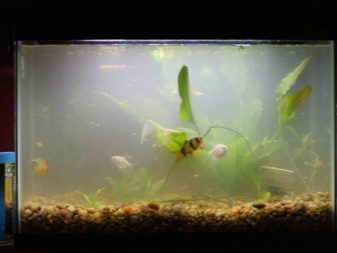
Submission methods
Carbon dioxide can be supplied in several ways.
Mechanical
According to many experts, the supply of CO2 to the aquarium using a balloon installation is considered the most effective. The cylinder can be bought in a specialized store and, following the instructions, ensure the flow of carbon dioxide into the aquarium. The disadvantage of using this option is that This installation is suitable exclusively for large tanks. Also, the user may encounter with a high cylinder cost.
The large dimensions of the structure also cause inconvenience. which includes an electromagnetic valve, a system for monitoring the spray element, the actual cylinder and other parts. If safety precautions and operating instructions are not followed, an explosive situation is possible. There are many advantages to the mechanical option for supplying carbon dioxide.
Balloon installations are considered quite economical, as they can accommodate a large volume of matter, they are characterized by a stable gas supply, as well as an automated process.
When buying a unit, you should give preference to what has flat bottom, as well as a valve, which corresponds to GOST. The cylinder must be marked in a special way, and the gearbox is equipped with a solenoid valve and fine adjustment. The presence of a counter is considered desirable, it will help to track the amount of CO2.

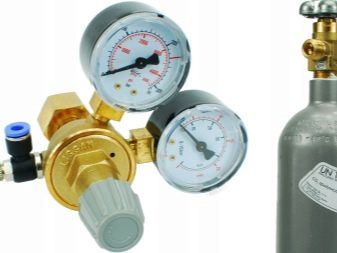
Chemical
The basis of this method is the mixing of reagents, which as a result emit carbon monoxide. Reagents are a worthy alternative to the previous option, because instead of cylinders, you can buy tablets in a specialized store. The chemical way of CO2 supply is considered quite simple, effective, practical and safe. One tablet is enough to provide the necessary volume of carbon dioxide 20 liters of liquid medium. The disadvantage is the constant need to buy new pills.
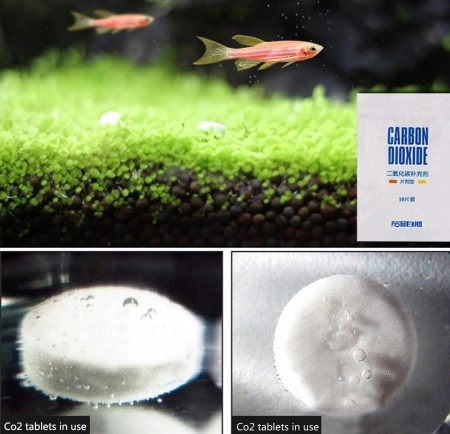
Fermentation unit
This option is considered the most creative, since it is based on the independent manufacture of a generator in which fermentation takes place. The result of the design is the emission of CO2. The disadvantage of the generator is the inability to control the process, as well as the risk of gas leaks. The indisputable advantage of the unit is its low cost.
There are many options for these designs, the most common of which can be called a generator, the basis of which is soda and citric acid. Sparkling water as a source of CO2 is also an excellent option for providing an aquarium. After the bottle is opened, it contains carbon dioxide in an amount of 1450 mg. To provide the aquarium with a vital component, 20 ml of soda is enough.
The main advantages of using this method is profitability and simplicity, and disadvantages - instability of gas concentration, weak supply of a substance. To raise the bubbles from the bottom, the cheapest water is suitable, while it must pour daily.
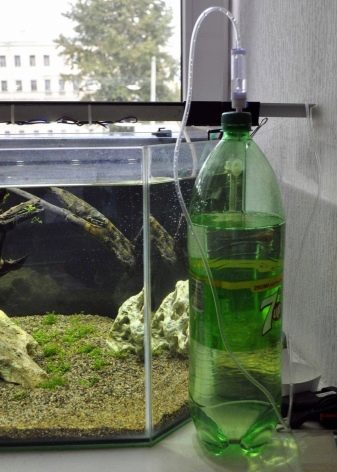

Automizer
This unit is considered highly efficient flow diffuser that operates on reverse osmosis. It spreads CO2 when sprayed. Automizer provides high-quality dissolution of carbon dioxide in the water of the aquarium. For proper operation of the unit, its location must be vertical, so the gas will be atomized with maximum force.
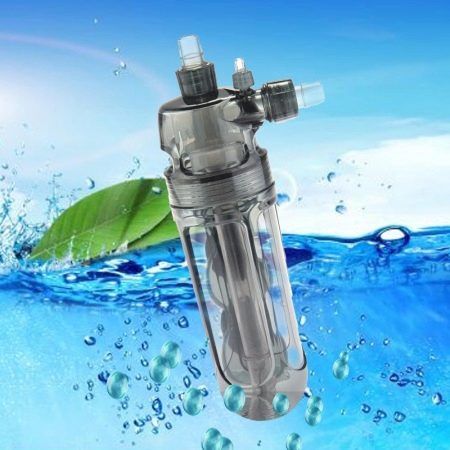
Types of sprayers
After you choose the method of generating carbon dioxide, you can proceed with the selection of the atomizer, diffuser. The most common options for these devices can be called the following.
- Bell. It is also called an inverted cup. It has the appearance of a small plastic or glass container that is filled with water. The bell is placed in the aquarium so that the open side is below. After that, the unit from the cylinder is filled with CO2. Throughout the day, carbon dioxide is gradually consumed from a glass, and by evening it is refilled with liquid. In the morning, operations are repeated. This type of device is considered optimal for small aquariums.
The main advantage of the bell is that when you use it, you won’t be able to overdo it with a dose of CO2.
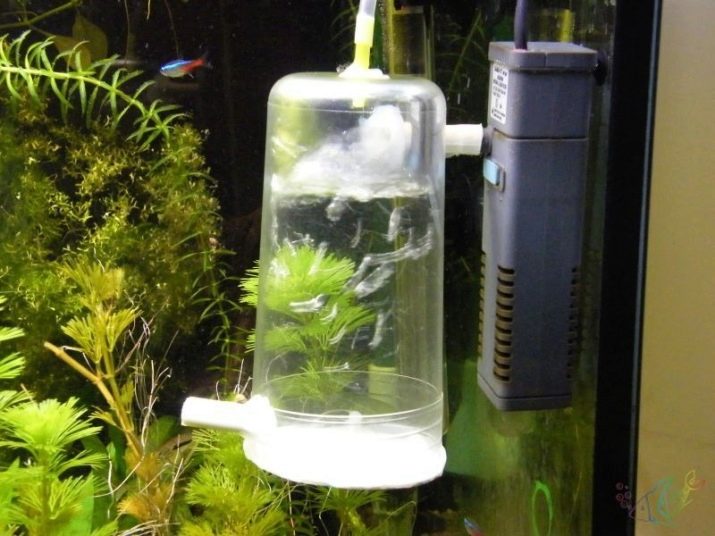
- Diffuser made of wood. This type of sprayer is usually made from hardwood. The diffuser is able to create small gas bubbles that contribute to the rapid dissolution of CO2. The advantages of this unit include simplicity combined with efficiency. The disadvantages are the need to supply gas exclusively under the influence of high pressure. The disadvantages of a wooden diffuser are also considered variable performance and fragility. Units of this type can be bought or created with your own hands.
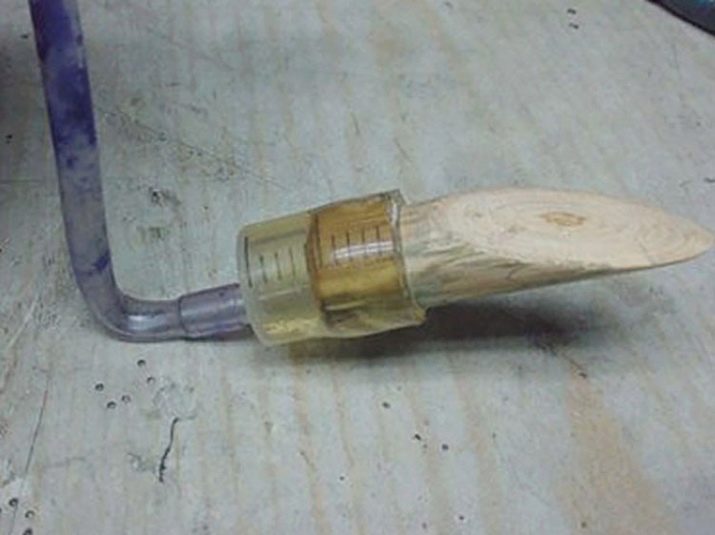
- Glass-ceramic and membrane diffuser are the most common options. Gas is supplied to a container of glass that is under water. In the upper part, it is closed with a glass disk or a plastic membrane. Through small holes on the surface of the unit, gas is forced into water at a low speed. In this case, CO2 has the appearance of small bubbles.
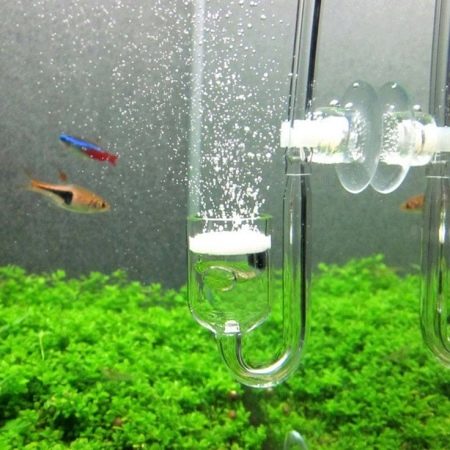
- Bubble ladders. These designs look like glass and plastic transparent labyrinths. In them, each of the bubbles of carbon dioxide, which is launched from below, rises with little force into the upper part of the water, gradually dissolving in it. This bulky thing does not need to be decorated, since the release of bubbles in itself has a bewitching appearance.
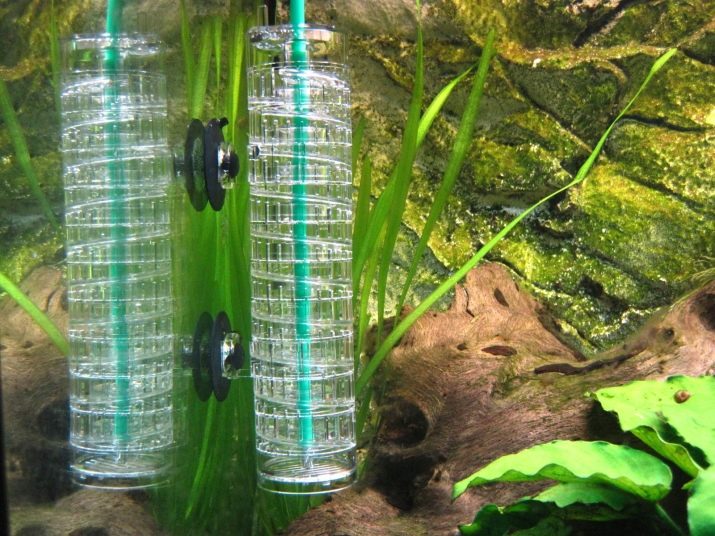
- Active pumps - These are carbon dioxide reactors that are created using the latest technology. They can be characterized by a variety of designs, but at the same time a single principle of operation. The flow of water is directed towards the gas bubbles, at which time the braking and dissolution of the latter occur. The disadvantages of the pumps include their technical complexity. But the advantages are efficiency and lack of pressure.
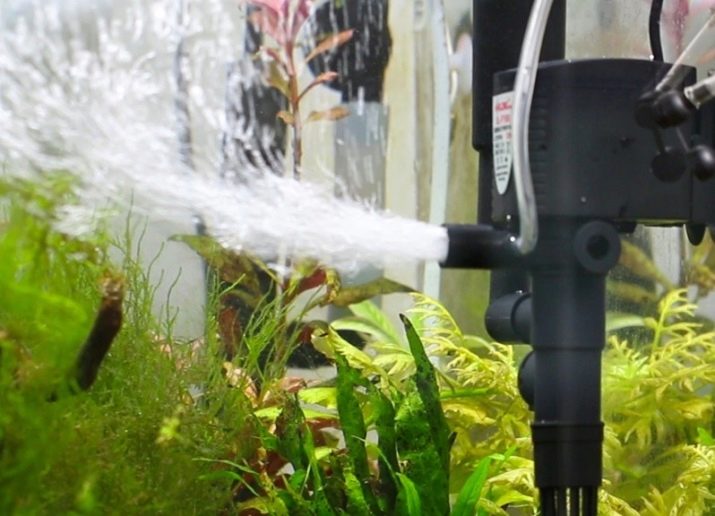
How to make?
Nowadays, many aquarists make do-it-yourself CO2 supply systems. This equipment can be created from a fire extinguisher, for example, 2 kilograms. In this case, a system with pressure gauges and a regulator in the form of an exhaust valve will also be necessary for operation, which will be able to withstand the pressure of carbon dioxide from the cylinder. Using a wrench, the tube with the spray bell is removed. To make the action as safe as possible, do not get rid of the locking pin on the lever.
After installing the pressure gauges in conjunction with the outlet valves, you can proceed to extract the safety pin.
To avoid personal injury, do not overtighten the pressure gauge system during installation. To check the operability of the reactor, it is better to take it out of the room. When you press the handle, you should not expect explosions, the only thing you can hear is a quiet hiss. Such a sound indicates that the work on creating a CO2 supply system was performed correctly.
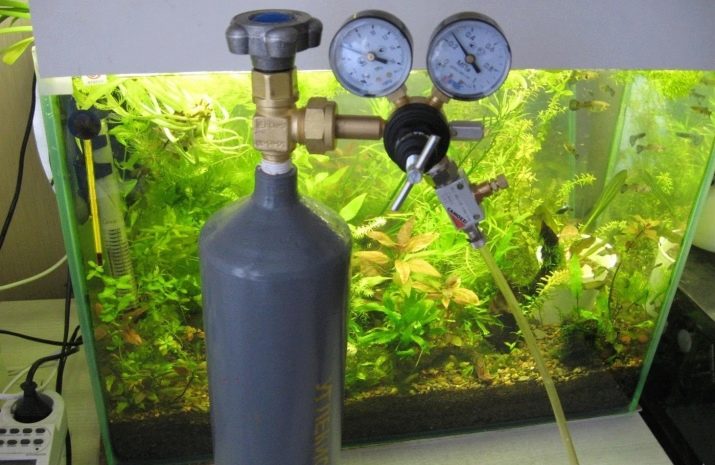
A pressure gauge should show a value of approximately 50 bar, provided that a 2 kg fire extinguisher was used. You can set the carbon dioxide output in any amount that will suffice for your aquarium. To fix the necessary mode, it is worth using an insulating tape. Check for gas leaks with soap.
The next step is to link this system to a carbon dioxide bubble counter and a reverse valve. This event will help prevent liquid from entering the cylinder and its components. After setting the number of bubbles, you can place the system in the aquarium. At the end of the installation, do not forget about fixing the fire extinguisher.
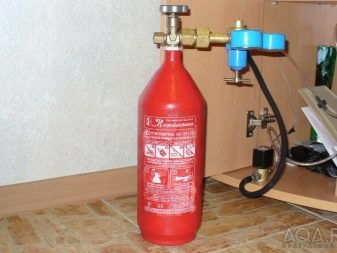
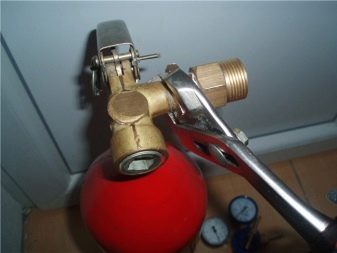
How to control the level?
One of the vital aspects of the aquarium, which should be constantly monitored, is the concentration of carbon dioxide in the water. The procedure can be performed using the following devices.
- Dropchecker test. The appearance of the device has the form of a drop that is filled with liquid for indication. This indicator responds qualitatively to changes in CO2 content, showing the result with a color change. For example, yellow means an excess concentration of carbon dioxide, green means its maximum amount, and blue indicates a lack. Dropcheckers are quite easy to use, but they act very slowly.
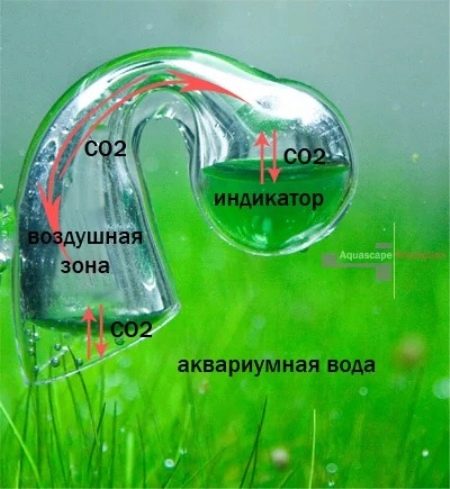
- Liquid is an indicator. Thanks to this method, it is possible to determine the amount of CO2 in an aqueous medium within a few minutes. This indicator is able to show carbonate hardness. The color that was determined on the device can be compared with the color table and estimate the amount of gas present in the water. Using this method is quite simple, the inconvenience can only cause the need for a constant fluid change.
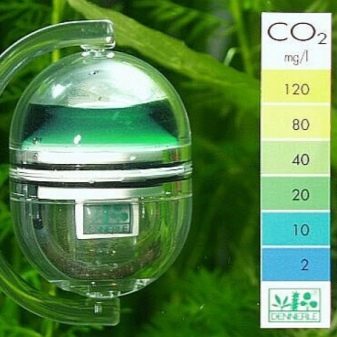

- Observation. This method is considered the most unreliable, since its basis is the subjective opinion of the observer. In this case, the aquarist needs to track the behavior of the fish, the growth and development of vegetation, while noting the atypical nature of their condition.
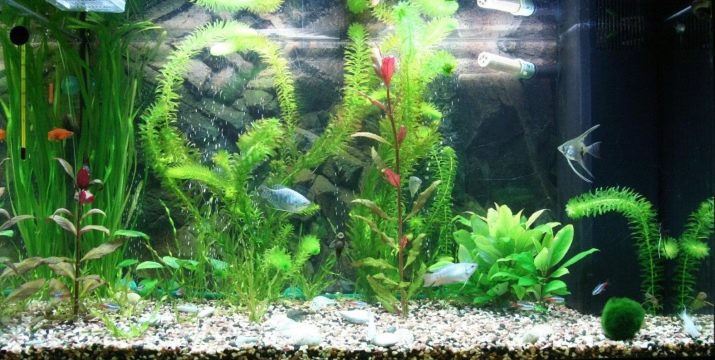
Each owner of the aquarium should know that the CO2 content in the water should not be treated negligently, since this gas is very important for the normal functioning of vegetation and, as a consequence, for other inhabitants. After acquiring a tank, it is worthwhile to start installing carbon dioxide into it.
The main rule, which should not be violated when keeping the aquarium, says that not only a deficiency, but also an excess of carbon dioxide can be detrimental to its inhabitants, therefore, this indicator must be constantly monitored.
See below for a video on adding carbon dioxide to an aquarium.










